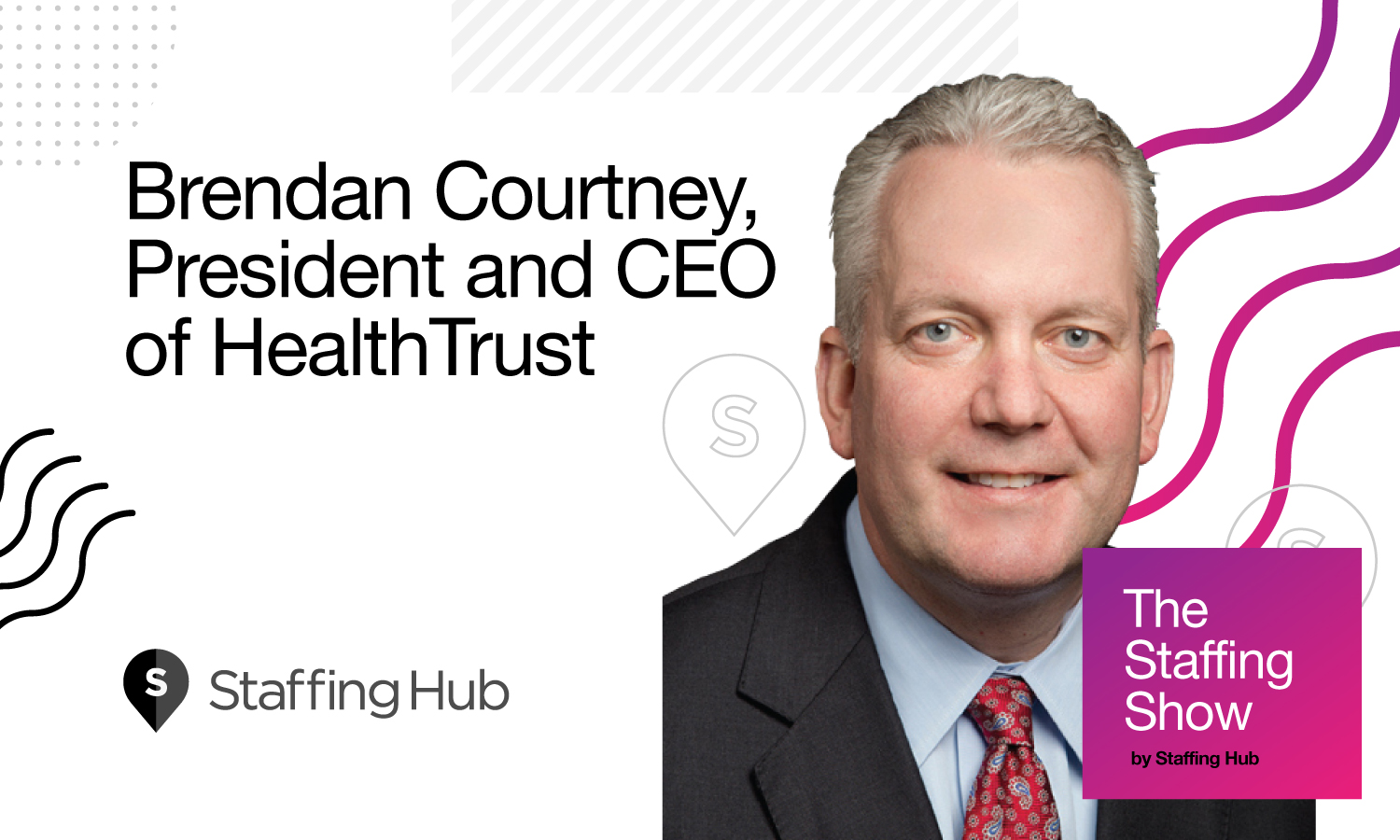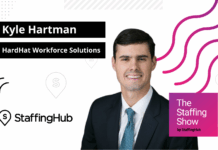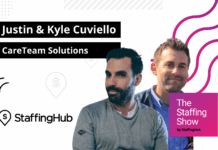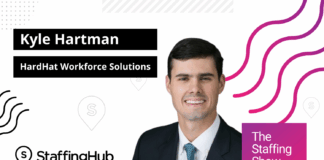
I sat down and chatted with Brendan Courtney, President and CEO of HealthTrust Workforce Solutions. He details the differentiators that have lead to the company’s double-digit growth for the past four years, underscores his team’s commitment to being easy to work with, and HealthTrust’s answer to the nursing skills gap.
Here’s the transcript of the episode.
Staffing Hub: HealthTrust has seen double-digit growth for the past four years now. If you had to distill it down to just a few unique qualities, what would you say sets HealthTrust apart?
Courtney: That we provide a service in the healthcare staffing industry that’s different than all of our competitors. And that when you look at the service offerings that we provide, as it relates to healthcare labor management, the various competitors have very different service offerings. The point is there isn’t any one firm out there who we compete against across all of our service lines.
So, to be more specific, we have our advisory services business, which goes in and helps healthcare systems do a better, more efficient job of managing their labor. We go in and do labor productivity assessments to show healthcare systems where their are opportunities to create a more efficient schedule. This allows them to manage their full-time resources more efficiently and more effectively, which typically increases employee satisfaction and ensures a good quality schedule.
This is obviously in everybody’s interest, but most notably it also creats great patient experiences within the hospital systems. And by managing their full-time employees more efficiently, we actually help save them money because they end up using less contract labor. So when you look at that piece of our business, it’s very different than our other staffing industry competitors. No one else has that service offering. It’s consulting firms that we compete with, in that space.
And when it comes to the MSP space, one thing that’s very different about us is that we truly view ourselves as an MSP. We are a master service provider.
A lot of our competitors in the healthcare staffing space, they go into MSPs looking to be the primary staffing provider. I would tell you, they’re more master staffing providers, not master service providers, in that we provide just a very different level of service.
We’re not trying to fill our MSP client’s orders with our own nurses. We’re just trying to fill for our MSP clients, as quickly as we can, the right resource at the right time.
And so, it’s a very different experience with us as your MSP as opposed to some of our other competitors in the healthcare space.
In some cases, we haven’t won deals because the health systems like the idea of having a primary staffing provider. But in most cases, they like our vendor neutrality, and they like the fact that we’re trying to fill their job as quickly as we can with, again, right resource, right time.
One of the other things that make us very different is we’ve got a credentialing service offering that we provide. We ensure, from a patient safety standpoint, that all the individuals who enter healthcare facilities are appropriately credentialed based on what kind of, and how much, contact they have with patients. And again, we compete in that space with a whole other set of competitors. And just like our advisory services business, none of them are staffing companies.
And then, finally, we’ve got an educational service offering where we do EMR training on several different EMR systems. So, whether it’s MEDITECH, Cerner, or Epic, we train our clinicians on whatever tool the healthcare system and facility utilizes, so that from a productivity standpoint, when those clinicians arrive at the facility they aren’t having to figure out their EMR system. They’ve already been trained in advance. So from a productivity standpoint, it allows them to hit the floor running because they’re not having to figure out the EMR tool.
The other thing that is big from an education standpoint is this whole skills gap that exists between new nurse grads and who can get hired by healthcare systems. New nurses always have a hard time finding their first nursing role coming out of nursing school, because they don’t have any experience. And then, you’ve got healthcare systems that can’t hire new nurse grads because they don’t have a training program and that they only want to hire nurses with a minimum of one year of experience.
In fact, if you go onto the internet, you’ll see that RNs is the single most advertised open position on the job boards. And all of them start out with a minimum one year experience. Everybody’s looking for that one year experience as a threshold to get hired, so that new nurse grad struggles to find their first position.
So, we’ve got a nurse training program. We refer to it as StaRN, which is an acronym for Specialty Training Apprenticeship for RNs. It’s a 12- to 14-week training program that takes new nurse grads and runs them through a combination of classroom training, simulation training, and preceptorships … And it’s different by virtue of what kind of a specialty nurse training program they’re going through, so OR nurses, NICU, and ICU nurses, those programs are a little bit longer than say a typical med-surg nurse program.
At the end of that 12 to 14 weeks, because of the accelerated educational process, the graduates of StaRN are able to take on a patient caseload on the other side of a 12- to 14-week training program.
So, again, there a couple of other companies out there that have nurse training programs. A lot of nursing schools have this as a service offering, but there isn’t anybody from a staffing standpoint, or from a healthcare labor management standpoint, that does everything in terms of the front end of coming into help healthcare systems manage their full-time labor better, all the way to the backend where we’re helping them train new nurse grads coming out of nursing school. And essentially doing anything in between from an MSP, as well as, from a staffing standpoint.
Staffing Hub: It sounds like you’ve built a holistic system that takes everyone from that new nurse grad right on through to the hospital administrator who’s looking to fill 100 nursing shifts. What would you identify in your organization as … What in your culture has allowed for this innovation, this sort of holistic perspective on the entire staffing experience?
Courtney: I’ve been here for about five and a half years, and when I got here, early on I recognized a couple of things.
One is, we as a company needed to become easier to do business with. Whether you were a nurse who worked for us, whether you were a client that we supported, or whether you were one of our strategic vendor partners who provided nurses to our MSP programs, we recognized we needed to become easier to do business with. We needed to develop a more customer-centric culture where customers came first.
And again, we view our customers as those three constituents.vNurses, the vendors who support our MSP programs, and then the client that we support from a healthcare systems standpoint. And then, ultimately, that’s all done with the corporate mantra that we all live every day, and that’s focused around operational excellence.
It may sound corny, but we refer to it as the Workforce Way. And the Workforce Way at HeathTrust is that we are constantly working every day to become easier to do business with.
Every business process we look at, we think about it in a context of operational excellence. What’s the best way to do something? And then, we move towards managing our business processes in that direction.
And I will tell you, Caitlin, five years in, it’s great that the personality of the company has changed dramatically.
Our employees, right down to the most junior person within the company, feel empowered to come up with ideas, to make recommendations.
We give a quarterly award we refer to as the HealthTrust Hero Award. And that’s for the associate that comes up with the best idea to improve a business process, that we in turn implement. We recognize people quarterly. And it’s all about making us be easier to do business with, with again, operational excellence as the backbone on how we guide our day-to-day activity.
Staffing Hub: What are some ways that you … Well, you’re obviously influential in the industry. You’ve been named one of the most influential people by SIA for a couple of years now. I’m curious about your leadership style and what you do to foster those HealthTrust Heroes, and foster that sense of innovation and empowerment.
Courtney: You know. I would tell you that the most important thing that everybody in the company recognizes, it’s not just me, but me and my immediate leadership team, we’re all very involved in the day-to-day operational aspects of the business. We get involved in what’s happening across the company on a regular basis, whether it’s weekly, monthly, quarterly. We’re constantly being involved operationally in all elements of the business, but we do it in a way that we’re there to help, that we all grew up in the business, and so we’ve all got very hands-on experience in the business.
And they’re very constructive conversations, which typically we’re talking about all the positive things that are happening within the company. It allows us to focus on where we want to improve the company.
With a leadership team that’s that hands-on, with an employee base that feels empowered to make recommendations, and to help improve every single business process within it.
Once we identify something that we do want to change, the velocity at which we’re able to drive change through our organization, because we’ve gotten so much better in a relatively short period of time, we’re able to drive change through the company very, very quickly without a lot of the consternation that’s very typical of companies that have difficulty with change management. Ours is just the opposite. It tends to be embraced because, as a company, everybody’s so interested in continuing to improve, and continuing from, again, the mantra of operational excellence, and becoming easier to do business with.
Staffing Hub: Could you give us some ideas of the kinds of quick changes you’ve been able to make recently? The tools, or techniques that you’ve adopted that help facilitate this, that help make your org easier to work with.
Courtney: Well, we implemented a system through Erecruit, which we’ve branded internally as Workforce 2.0. So all the companies, the nurses that we work with, and the companies that do business with us, they work in that tool, literally, every day.
We have user groups and focus groups that meet regularly on looking at Workforce 2.0, and what changes can we make systematically to enhance the user experience, to enhance the customer experience?
It’s all in the spirit of helping us get easier to do business with. We’re constantly enhancing our system, the toolkit in which everybody operates day-to-day, in an effort to drive change.
The other thing that we’ve done is we’ve got an internal group of operational folks who work with each one of our lines of business from an operational perspective. And look at opportunities to improve business processes and efficiencies.
So, each department has its own operations director, and then they all work as a collective team collaboratively sharing best practices to look at ways that we can continue to improve across the whole company. Not just the respective departments within the company, in terms of silos, they’re fixing the silo that they’re attached to, but they’re part of team that orchestrates solutions across the whole company. And so, we’ve been able to adopt the best practices of all the different departments. And again, if it comes to the velocity of which we’re able to get that done, we can make things happen very, very quickly because of it.
Staffing Hub: I’m curious how you would apply this perspective to the industry as a whole? You have 25 years of experience in staffing, and I’m wondering what you identify as the biggest challenges facing healthcare staffing right now, as a whole?
Courtney: I’d answer that question two ways, Caitlin. Number one, with the experience that I’ve had in the industry, I grew up on what I’ll call the retail side of the staffing industry. Where having been in the industry as long as I have, I pre-date MSPs and VMSs.
And so back when I got into the industry, it was all retail. You were working directly with the hiring manager. You were making placements. Our fees were on a percentage basis, higher. On the staffing side, the mark-ups and bill rates were higher than they are today. And as the industry became commoditized, to me, there’s now two different delivery models. One is wholesale and one is retail.
In the healthcare staffing space, both still exist. But here at HealthTrust, I would tell you that we are a classic example of the wholesale delivery model. And when I grew up in my career, I recognized that when you’re supporting and servicing the wholesale side of the staffing industry, you had to rationalize in your mind, as a service provider in that space, that you were willing to give up margin for volume and ease of doing business with.
And so, I recognize that for us to be on the wholesale side of the staffing industry within healthcare, that we have to be easier to do business with. Because if our staffing partners, that support our MSP programs, have an option on do we want to work on a HealthTrust order, or do we want to work on another MSP’s order?
If we’re easier to do business, and if they have a higher degree of success with us, then the recruiters, who only have a certain amount of time and effort that they can put into their day, our hope is that we want to create an environment where they want to work on a HealthTrust job over our competitor’s. So that’s one piece of it. Recognizing that we’re a wholesale delivery supplier and that we’ve got to make it desirable to want to work with us versus others.
The other answer to your question is that when I look at HCA, who’s our parent company, one of the strengths, among many, of HCA as a company, is their ability to operationalize business processes, refine them, and make them as efficient as possible.
As a subsidiary of HCA, everything that we do starts out as an idea. We pilot these ideas. We operationalize the business processes. And then we get really, really efficient at how we delivery whatever the services line is that we’re going to deliver against. And so we are part of a company in HCA that operational excellence and efficiency in everything that we do is one of the success quotients of a very, very successful company. So it’s inherent to the way that I grew up in the industry, and it’s inherent to how all of HCA runs as a corporation.
Staffing Hub: Can you give me an idea of some of the ways these efficiencies look operationally? For example, what larger challenges do you feel like you have successfully molded into a workable, efficient process that helps everybody do business a little bit easier?
Courtney: That’s a great question. When I moved into healthcare, I had some friends in the industry who kind of warned me, or alerted me to the biggest difference in healthcare staffing is the degree to which healthcare, especially on the clinician side, how healthcare providers need to be credentialed and the management of those credentials is critical to part of the service offering of being in the healthcare staffing space.
So, getting a nurse or getting a physician credentialed is a long, arduous process. When you talk to anybody in the healthcare staffing space, they can tell you that it takes anywhere from 30 to 120 days to get a nurse credentialed to make them eligible to be able to go to work.
Part of that is because the process is we’re relying on the nurses getting us the proper documentation, certifications, and licensure, etc. But then the whole business process of collecting those, verifying that the information is true, etc., is just a long drawn out process.
When I first got here, we were averaging more than 90 days to get a nurse credentialed. We’ve worked for years on that process. With all the business process changes we’ve made, with the software enhancements that we’ve made, with the tools that we’ve put in place, we now can get nurses credentialed and ready to work in less than 10 days.
So we went from 90+ to 10 days. That’s a benefit to the nurses that we’re working with, that’s a benefit to the client that we’re providing staffing services to, and that’s a benefit to all the vendor partners that we have that are having to, whether it’s travel nurses or per diem nurses working through our programs, to support our client base.
That’s typically the longest part of the hiring process, to get nurses to go to work, and again, we took it from what was a 90 plus day process a couple of years ago, to now we can get it done in less than 10 days.
Staffing Hub: How did you do that? Can you talk about how you did that? It’s impressive.
Courtney: So, part of it is systematic. We through our Workforce 2.0 implementation, we’re using software to gather the credentials.
We built the tool in a way that our credentialers can look at the credential, approve the credential, and communicate back and forth with the nurses through emails and texting to say, “Hey, we’re still waiting for this document,” or, “Hey, that document isn’t the right document. You need to give us a different one.”
So, we’re using more modern technology to do that as opposed to emails and what used to be phone calls.
We’re engaging with the nurses differently in that we’re talking to them about how they need to be more participative in the process and that if they want to go to work quickly they need to get us the data points quickly. We’ve worked with our background check vendors to pressure them to get to background check processes done faster.
So, it’s been a combination of a lot different things. The other thing that we did is we used this operations team to look at all the business processes. We thought that things were being held up within our credentialing department, but through our operational audit, we recognized that in some cases the field owned some of the hang-ups in the process, and in other cases recognized that the program office that manages our MSP, that they were holding up parts of the business processes.
Where one department was sort of pointing the finger at the other department as, “Hey, you’re keeping the process from getting better.” This operational audit team went in there, looked at all the business processes, and defined where the hold ups were.
We were able to again knock down some of the barriers, identify where the hold ups were, get the business processes changed and having our people adopt new business processes to again accelerate the process through credentialing to again improve the overall experience for everybody. And again, it’s one where our internal employees like the processes better, the nurses like the processes better, our vendor partners like the processes better, and ultimately our clients like the processes better ’cause they get nurses on the floor faster.
Staffing Hub: Maybe this is related to breaking down bottlenecks, creating more efficiencies, or maybe you’ll take it in another direction, but I’m wondering how you see the healthcare staffing industry evolving over the next few years.
Courtney: I think that the buyers of our services are becoming more educated and more sophisticated, and I would say that healthcare is notorious for being behind a couple of business cycles as it relates to business processes. So the fact that you’ve got some fairly large and some mid-size and small healthcare systems that aren’t taking advantage of buying their contract labor through MSPs and utilizing BMS tools to create governance, to create efficiencies, to create visibility, that is getting accelerated.
So that is going to change the dynamic of this whole wholesale versus retail business mix, and that right now while there’s still a pretty healthy balance between the two, I think you’re gonna see the scale weight towards more staffing services within healthcare are gonna get bought through the wholesale model of MSPs and VMSs.
That will be a major change within all healthcare. The other big thing is that the war for talent isn’t gonna slow down. The reality is there just aren’t enough nurses going through nursing school to deal with the gap between as many as a million nurses, between how many nurses there are in the US and how many nursing openings there are.
And you’ve got the same paradigm that exists on the doctors side. There aren’t enough doctors, there aren’t enough locum tenens, and so between physicians and nurses, there’s still going to be shortages.
So, those firms that continue to be able to create scale, get bigger, are able to create the delivery model to successfully compete in what’s gonna be a more wholesale oriented staffing space, will be the winners as healthcare becomes smarter buyers of services.
You know when you look at healthcare systems, the two most expensive line items on a healthcare system are supplies and labor. The GPO space of healthcare is 15-20 years old and they continue to get better and better and more efficient.
Now labor is starting to catch up, both in terms of the engagement that healthcare systems are working towards to get them more engaged full-time employee based, but also engaging with staffing providers because the staffing, the use of contract labor is part of literally every healthcare system in America. They’re continue to become more educated, more sophisticated buyer of those services.





